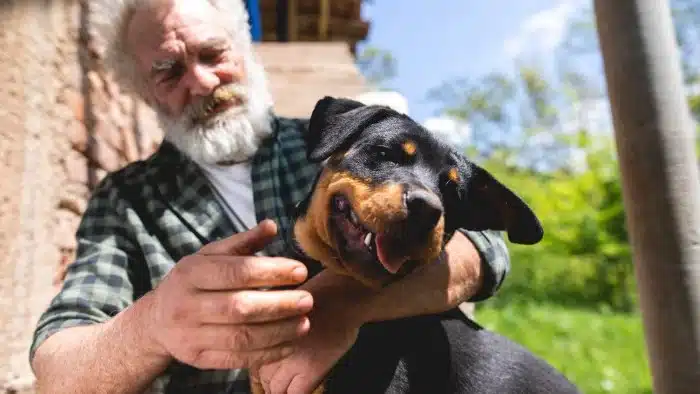What Should I Do When My Dog Gets Lost?

“Just stepped out to take out the trash, and my dog disappeared—where should I start looking?”
“Took my dog to the park, looked away for one second, and it chased a butterfly and vanished.”
For dog owners, a lost dog is one of the most frightening moments. Rushing around unthinkingly not only wastes time but also makes you miss the best window of opportunity. In fact, the golden time to find a lost dog is the first 24 hours. With the correct method and a clear plan, your chances of bringing your dog home increase significantly. To stay calm in an emergency, you need to understand the basic logic of “what to do right after your dog goes missing.”
1. First Stage: The First 1 Hour — Act Fast During the Easiest Time to Find Your Dog
In the first hour, most dogs don’t run far. If your dog is familiar with the area, it is likely still nearby, wandering in places it knows. Your goal is to lock the search area quickly and reduce the dog’s fear.
Step 1: Stay calm and confirm where and how it got lost. Think about the details:
– Did the dog run out from the doorway?
– Did it slip off the leash in a park?
– Did it run off in an unfamiliar place (moving homes, travel, etc.)?
This helps you set the first search zone.
Step 2: Call people around you and divide tasks.
One person is not enough, especially when searching a wide area. Quickly ask family, friends, or neighbors for help.
Assign roles clearly:
1 person stays near the lost location (dogs often return).
2–3 people search in different directions.
1 person contacts property staff or park managers to check cameras.
Share updates every 15 minutes to avoid repeating or missing areas.
Step 3: Bring familiar items to attract your dog.
Carry your dog’s favorite toy, blanket, or snack bag. Shake the snack bag gently while walking and call softly. If your dog responds to specific sounds (a bell, whistle), use them every few minutes.
Avoid strong lights or loud shouting, especially at night—this may scare your dog further away.
2. Spread the Information: Use Both Online and Offline Channels
If you still can’t find your dog after an hour, start spreading information immediately. “Offline + online” works best. The more people who see your message, the higher the chance someone has seen or kept your dog temporarily.
Offline
Your goal is to make people within 1–3 km aware quickly.
Post flyers: Print 50–100 copies with clear photos, key features, lost time/place, and multiple phone numbers. Mention a reward.
Talk to people nearby: Tell cleaners, guards, shop owners, and leave your contact. In markets, ask vendors or management staff.
Contact local authorities: Ask the property or nearby stores to check CCTV. If you think local officers or rescue teams might have taken the dog, call them to check records.
Online
This widens the reach and helps people in other areas seeking your dog.
You can post in neighborhood groups and pet groups. Small rewards can help spread the info.
And share a short video or clear photos with local tags. Run a low-budget local ad.
Pet platforms are also a good choice. Post on pet-related platforms and contact local pet clinics. These are key places where a lost dog may be found.
3. On-the-Ground Search: Adjust Your Strategy Based on Your Dog’s Personality and Time of Day
While spreading information, continue searching in person. Dogs behave differently depending on their nature and the time of day.
By Dog Personality
Shy dogs (like chihuahuas, corgis):
They hide in quiet places—under cars, in bushes, in stairwells. Search slowly and avoid scaring them. Place a blanket with your scent and use a small camera if needed.
Active dogs (like golden retrievers, border collies):
They move fast and may follow busy routes. Search near roads, parks, and ask passersby. In some cases, contact the traffic police.
Older or sick dogs:
They stay close, usually within 1 km of each other. Check warm and sheltered spots.
By Time of Day
Daytime (6:00–18:00):
Expand the search. Visit familiar places and ask more people.
Night (18:00–6:00):
Use a soft light and call gently. Place items with your scent at your dog’s usual potty spot to attract it.
Important:
At night, stay safe. Avoid dark, isolated places alone. Go with another person.
If your dog is near a road, do not suddenly run toward it. Approach slowly and use treats to guide it to safety.
4. After You Find Your Dog: Calm It, Check It, Prevent It From Getting Lost Again
After bringing your dog home, don’t celebrate too quickly. You need to calm the dog, check its health, and make sure it doesn’t happen again.
Emotional care
A dog may be scared, shaking, hiding, or refusing food. Don’t force hugs or interaction. Please put it in a quiet, familiar spot at home. Give a small amount of its favorite snack and water. Speak softly and pet it gently.
If the dog still refuses food or keeps shaking for more than 24 hours, take it to a vet.
Health check
Check for injuries—scratches, bites, wounds. Look for bugs or grass stuck in the fur. Check the mouth for foreign objects.
If the dog was gone for more than 24 hours, observe its poop and take it to the vet for tests (disease screening and blood tests).
Losing a dog is a heartbreaking experience, but staying calm and following the steps—quick action, spreading information, on-the-ground search—helps most owners get their dogs back. When your dog finally returns and touches your hand with its nose, you’ll know every effort was worth it.
For dogs, their owner is their whole world. And for owners, keeping them safe is the most basic responsibility. Good prevention is the first line of protection for this precious bond.
